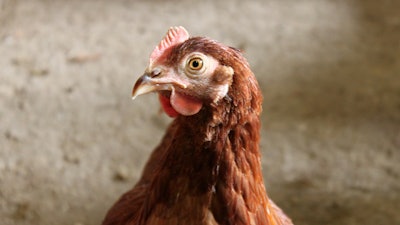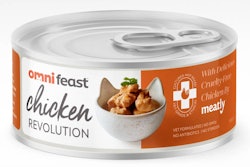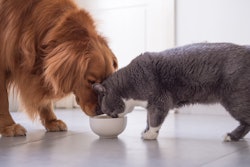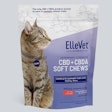
As opposed to creating whole-muscle meat, cell-cultured chicken slurry may overcome economic and technical challenges faced by lab-grown meats while providing amino acids and other nutrients for pet food. In June, BioCraft Pet Nutrition introduced a chicken cell line for both cat and dog foods. The cell-cultured chicken comes as a meat slurry, similar to that already used in the industry.
“The primary objective of BioCraft Pet Nutrition is to provide pet food manufacturers with a meat ingredient whose nutritional profile is most appropriate for our pets,” BioCraft founder and CEO Shannon Falconer, Ph.D., told Petfood Industry in an email. “In this way, solid muscle tissue has never been a focus of ours, since muscle tissue alone doesn't provide all of the nutrients that cats and dogs require. They also require those nutrients that animal cells manufacture and release. The great thing about the slurry format is that it 1) is an ingredient format that pet food manufacturers are already familiar with; 2) offers a superior nutritional profile to tissue alone as our ‘slurry’ includes both the nutrients inside the animal cell plus those nutrients animal cells manufacture and release into the confined growing environment; 3) is highly scalable; and 4) doesn't require any downstream processing.”
Cell-culture supporters believe the technology will fulfill the demand for animal muscle tissue without the need for ranches. Growing meat in vitro hypothetically could reduce pollution and habitat loss associated with rearing, slaughtering and transporting livestock. Along with sustainability aspects, animal rights advocates hope cell-cultured meat will decrease demand for cattle, chicken and other livestock kept in captivity. Cell-cultured meats also reduce the chance of zoonotic disease spreading from livestock and wild game to people. Nevertheless, the production of cell-cultured tissues requires specialized infrastructure, and the lifetime sustainability assessments of the products need to incorporate construction and other start-up costs. Producing meat the old-fashioned way remains much less expensive than cell-cultured steak. However, a meat slurry may address this economic hurdle faced by cell-cultured muscle tissue.
“Since our ingredient offer to pet food manufacturers is a meat slurry, we intend to be competitive with conventional meat slurry costs. And towards this aim, we are very close. At the time we commercialize, our cultured meat will be on par with the cost of conventional meat.”
Likewise, cell-cultured chicken slurry may be on par with conventional poultry meat in terms of its carbon footprint. A carbon footprint is the quantity of greenhouse gases released during a particular process, such as the production of a pet food ingredient.
“Among the most commonly consumed agricultural animals, chickens are the most efficient at turning crops into meat,” Falconer said. “Nevertheless, in a recent life cycle assessment of commercial-scale cultured meat, the authors found that cultured meat (including cultured chicken) stands to be three times more efficient at converting plant-based ingredients into meat than chickens. In the study performed by Sinke et al. (2023), the authors showed that in terms of carbon footprint, conventional chicken meat and cultured chicken are comparable. In terms of differences, cultured chicken requires less land and is responsible for fewer ammonia emissions (which are linked to negatively impacting human health) than conventional chickens.”
Along with ecological and environmental benefits, cell-cultured chicken slurry may provide superior nutrition to muscle tissue alone.
In general, the nutrient that the pet food industry focuses on the most is protein,” Falconer said. “But it is worth reminding people that protein is only one nutrient that our cats and dogs need. And, in fact, it's not actually protein, but rather the specific amino acids that comprise protein that are essential to pets (and all living beings). Animal protein is interesting because it's considered a complete protein - i.e., it contains all of the essential amino acids our pets require. Although different combinations of different plants can also provide complete protein, and some individual plants (i.e., soy) can provide a source of complete protein, the stand-out nutrients that are essential to cats (i.e., those nutrients that actually make cats carnivores) include more than complete protein -- such as arachidonic acid, taurine, vitamin A/retinol -- are not found in plants. This is why BioCraft is so focused on cultured meat versus alternative protein or recombinant animal protein alone. Carnivores require many essential nutrients that animal cells manufacture, and the only way to obtain all of these nutrients without synthetic supplementation is with cultured meat.”
Lab-grown mouse-meat cat treat aided by DNA research
Before developing the chicken cell culture line, BioCraft created mouse tissue in vitro. BioCraft changed its name from Because Animals earlier this year. Geneticists have studied mice for decades and developed a greater knowledge of their DNA than most other animals. Falconer’s team applied that biochemical knowledge when making cell-cultured mouse meat for use as a novel ingredient in cat treats.
“Currently, cultured meat is expensive, including cultured mouse,” Falconer said in an earlier interview. “But one of our biggest assets is that we're working with tissue from a species where a lot is already known in terms of biochemistry. This gives us a serious advantage over other, more traditional clean meat companies who are growing tissue for human consumption,” she said. “In contrast to the mouse, there simply isn't a wealth of scientific literature available on poultry and bovine genetics. We can use the many decades worth of scientific findings to quickly scale our growth of mouse tissue in a way that we otherwise wouldn't be able to do.”
Not only do scientists know more about how to grow mouse meat for pet food, but making treats for cats provides advantages to pleasing hungry humans.
“The benefit of working in pet food is that mouse tissue is only one ingredient among several others needed to make our cultured mouse cat treat,” Falconer said. “Unlike the human food industry, where folks are working on growing an entire chicken breast that has all of the three-dimensional properties of chicken breast from chicken, we're simply growing a monolayer of mouse tissue and including it with other ingredients to make a cat treat. That's a lot easier and cheaper.”
Scientists may have a long history of studying mice, but cats have hunted mice since long before humans arrived with can openers. U.S. regulatory bodies may approve cell-cultured mouse meat as generally recognized as safe (GRAS).
















